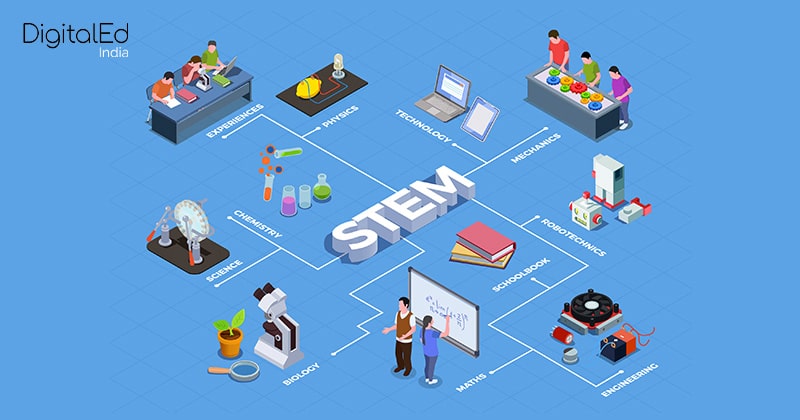Learning Tools in STEM Education; Importance, Impact and Opportunities
STEM is an acronym for an education system that is a combination of four specific disciplines: Science, Technology, Engineering, and Mathematics. In STEM classes, students learn all these four disciplines through an interdisciplinary approach. The focus here is on the application of the knowledge gained in the real world. Here students are trained to become not only learners, but Critical thinkers, problem solvers, and next-level innovators. STEM classes involve some mandatory laboratory (practical) classes where students get an opportunity to apply what they learn in the classrooms.

STEM is a technology-enabled learning approach, and its proper implementation is largely dependent on technology. The use of the digital medium in the field of education has brought about a revolutionary change in the way students learn today. Learning tools and technology used currently enables students to develop pro-active and self-directed learning skills. They are now able to identify what is important for them to learn, find and use online resources by themselves, apply the information gathered on the problem at hand, and even evaluate resultant feedback on their own. This helps to increase their efficiency and productivity. In addition to keeping students engaged in studies, digital learning tools, and technology work best in sharpening their critical thinking skills, which forms the basis for developing analytic reasoning. Children who research open-ended questions with a creative mindset and logic learn how to make decisions, instead of just temporarily memorizing the textbooks.
Use of learning tools in STEM education
Learning tools and technologies like learning through social platforms make it easy for teachers to create and manage groups of students. The shift from the traditional education system to digital learning can enhance the benefits of teaching, while giving more time to teachers to address individual and small group needs as per their requirements. The opportunity brought in by digital learning to design learning sequences for each student as per their understanding will make education more fruitful by meeting learning gaps sooner and accelerating the process of learning. Dynamic classification among students, workshops, assignments, and project-based learning with the help of learning tools can add lots of collaborative learning to the present education model.
We all know that digital learning is far more interactive and easier to remember than voluminous textbooks or one-sided lectures, as was the case in the traditional mode of learning. They provide better context, a greater sense of understanding, and have more engaging activities. All these features allow students to connect with the study material better. Further, these techniques also offer a more interesting and engaging way to comprehend information. This is clearly visible in their retention rates and test scores. Also, when students track their own progress, it results in greater motivation and accountability towards education.
Impact of learning tools
In recent times, the shift from print to digital medium has impacted how students are learning across the globe. This change is similar to the condition of the printing press, almost six centuries ago. This transition, brought in by technology, is transforming the formal education system and increasing learning opportunities for learners. Digital learning tools are not only enabling students to access more and more information online but also making sure that the information in question can be restructured and customized to their personal needs. The opportunity provided by learning tools to learn at their own pace and as per their level of understanding is the most important benefit of digital learning for the students.
Digital learning tools and technology allow teachers to rapidly share information with other teachers and mentors in real-time. The explosion of free, open information and online learning tools has created a system of shared economy. By embracing digital devices and connected learning, schools and colleges around the country and the globe can not only coordinate with each other to share insights, but also enhance the learning experience, and communications skills of students. The technologies also allow teachers to enjoy a level-playing field with one another. Schools are also able to save money while ensuring fair access to educational material as provided by expensive private schools.
Recommended digital learning tools in STEM Education
- Campus Ties: This website offers courses and built-in tests and assignments devised by trusted professionals and experts. Campus Ties also provides certificates to learners who have completed a course.
- Clean: Clean offers over 600 free courses and resources, created and verified by esteemed teachers and field experts.
- Energy-Gov: This is a US government-based website and here one can find free energy literacy videos that teachers can download to show their students. They also have a YouTube channel that supports anytime anywhere learning.
- Alison: This platform offers a variety of learning programs and information specially related to math and science subjects. They design their courses in a way that students can learn real-world applications of their knowledge. The site also offers useful tools for STEM teachers.
- MIT Blossoms: MIT Blossoms is a very popular platform that offers math and science videos for high school students.
- NASA Digital Learning Network: NASA is not discovering only new planets and galaxies. NASA is also providing a free-for-all digital learning network that offers premium lessons about space technology and other STEM education. They invite the most intelligent experts and verified speakers for their lessons.
Digital learning tools and technology in association with STEM education fill all the gaps where traditional classroom teaching falls behind. These learning tools help teachers and students save time by accessing information quickly and making the process of research easy for them. Digital learning, undoubtedly, provides an effective way to make academics cost-effective, maximize resources and have a great learning impact for students and teachers.